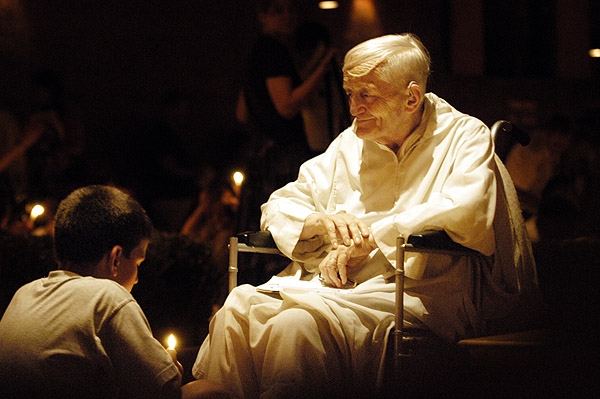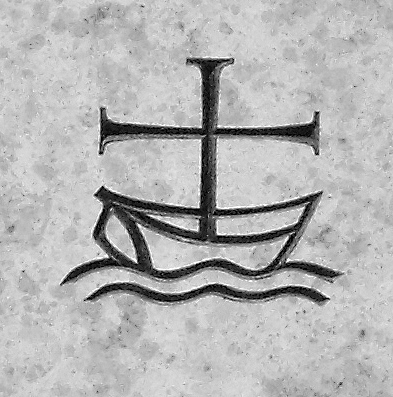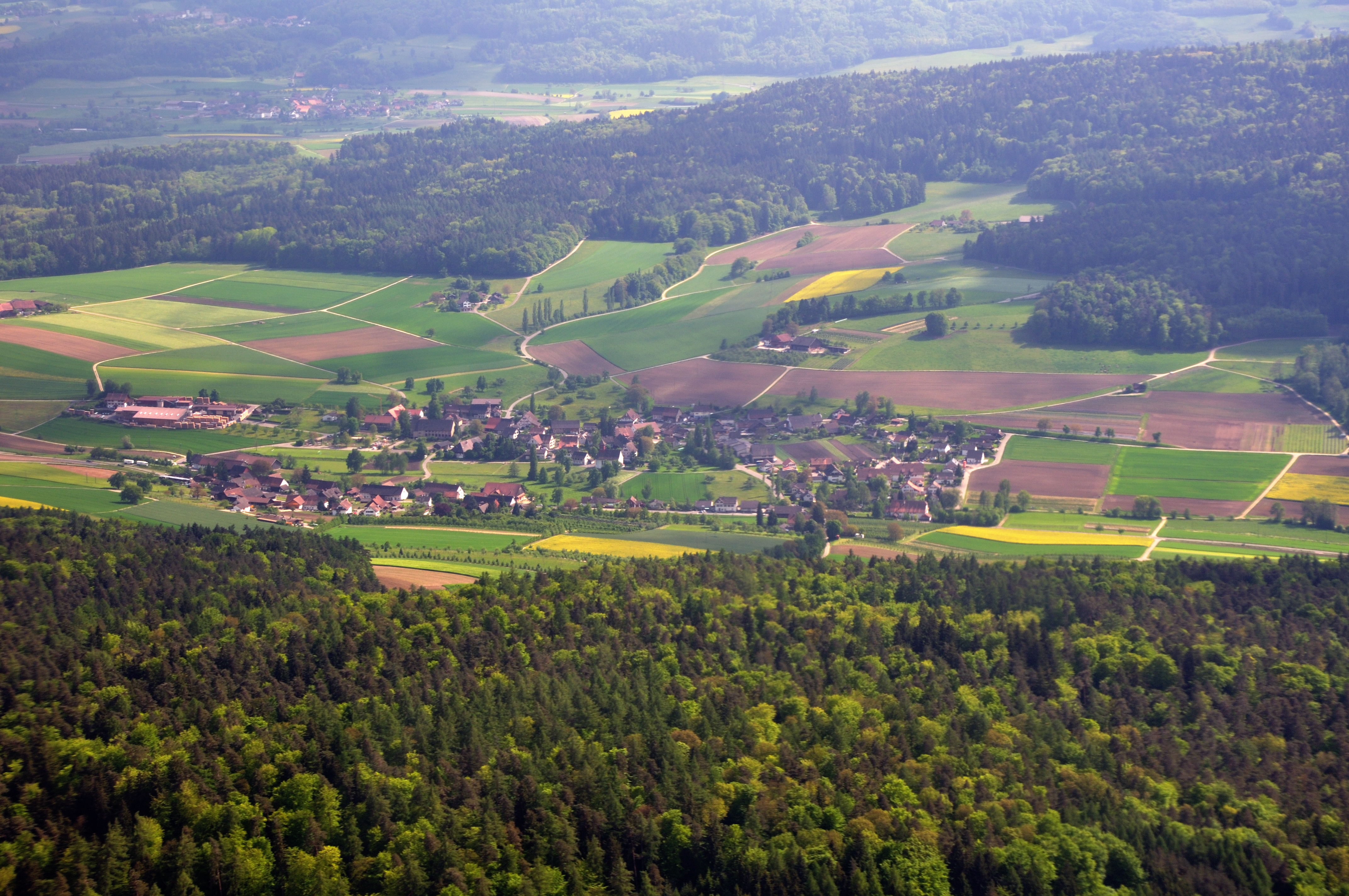|
Frère Roger
Roger Schütz (12 May 1915 – 16 August 2005), popularly known as Brother Roger (french: Frère Roger), was a Swiss Christian leader and monastic brother. In 1940 Schütz founded the Taizé Community, an ecumenical monastic community in Burgundy, France, serving as its first prior until his murder in 2005. Towards the end of his life, the Taizé Community was attracting international attention, welcoming thousands of young pilgrims every week, which it has continued to do after his death. Biography Background and early life Born on 12 May 1915, in Provence, Vaud, Schütz was the ninth and youngest child of Karl Ulrich Schütz, a Protestant pastor from Bachs in the Zürcher Unterland in Switzerland, and his wife, Amélie Henriette Marsauche, a Huguenot from Burgundy, France. From 1937 to 1940, Schütz-Marsauche studied Reformed theology in Strasbourg and Lausanne, where he was a leader in the Swiss Student Christian Movement, part of the World Student Christian Federation. F ... [...More Info...] [...Related Items...] OR: [Wikipedia] [Google] [Baidu] |
Brother (Christian)
A religious brother is a member of a Christian religious institute or religious order who commits himself to following Christ in consecrated life of the Church, usually by the vows of poverty, chastity and obedience. He is a layman, in the sense of not being ordained as a deacon or priest, and usually lives in a religious community and works in a ministry appropriate to his capabilities. A brother might practice any secular occupation. The term "brother" is used as he is expected to be as a brother to others. Brothers are members of a variety of religious communities, which may be contemplative, monastic, or apostolic in character. Some religious institutes are composed only of brothers; others are so-called "mixed" communities that are made up of brothers and clerics (priests or ministers, and seminarians). It is also common in many Christian groups to refer to other members as "brother" or "sister". In particular, the Christian Shakers use the title for all male adult members. ... [...More Info...] [...Related Items...] OR: [Wikipedia] [Google] [Baidu] |
Christian Ecumenism
Ecumenism (), also spelled oecumenism, is the concept and principle that Christians who belong to different Christian denominations should work together to develop closer relationships among their churches and promote Christian unity. The adjective ''ecumenical'' is thus applied to any initiative that encourages greater cooperation and union among Christian denominations and churches. The fact that all Christians belonging to mainstream Christian denominations profess faith in Jesus as Lord and Saviour over a believer's life, believe that the Bible is the infallible, inerrant and inspired word of God (John 1:1), and receive baptism according to the Trinitarian formula is seen as being a basis for ecumenism and its goal of Christian unity. Ecumenists cite John 17:20-23 as the biblical grounds of striving for church unity, in which Jesus prays that Christians "may all be one" in order "that the world may know" and believe the Gospel message. In 1920, the Ecumenical Patriarch ... [...More Info...] [...Related Items...] OR: [Wikipedia] [Google] [Baidu] |
World War II
World War II or the Second World War, often abbreviated as WWII or WW2, was a world war that lasted from 1939 to 1945. It involved the vast majority of the world's countries—including all of the great powers—forming two opposing military alliances: the Allies and the Axis powers. World War II was a total war that directly involved more than 100 million personnel from more than 30 countries. The major participants in the war threw their entire economic, industrial, and scientific capabilities behind the war effort, blurring the distinction between civilian and military resources. Aircraft played a major role in the conflict, enabling the strategic bombing of population centres and deploying the only two nuclear weapons ever used in war. World War II was by far the deadliest conflict in human history; it resulted in 70 to 85 million fatalities, mostly among civilians. Tens of millions died due to genocides (including the Holocaust), starvation, ma ... [...More Info...] [...Related Items...] OR: [Wikipedia] [Google] [Baidu] |
Brother Roger At Prayer
A brother is a man or boy who shares one or more parents with another; a male sibling. The female counterpart is a sister. Although the term typically refers to a familial relationship, it is sometimes used endearingly to refer to non-familial relationships. A full brother is a first degree relative. Overview The term ''brother'' comes from the Proto-Indo-European *bʰréh₂tēr, which becomes Latin ''frater'', of the same meaning. Sibling warmth or affection between male siblings has been correlated to some more negative effects. In pairs of brothers, higher sibling warmth is related to more risk taking behaviour, although risk taking behaviour is not related to sibling warmth in any other type of sibling pair. The cause of this phenomenon in which sibling warmth is only correlated with risk taking behaviours in brother pairs still is unclear. This finding does, however, suggest that although sibling conflict is a risk factor for risk taking behaviour, sibling warmth does n ... [...More Info...] [...Related Items...] OR: [Wikipedia] [Google] [Baidu] |
Tuberculosis
Tuberculosis (TB) is an infectious disease usually caused by '' Mycobacterium tuberculosis'' (MTB) bacteria. Tuberculosis generally affects the lungs, but it can also affect other parts of the body. Most infections show no symptoms, in which case it is known as latent tuberculosis. Around 10% of latent infections progress to active disease which, if left untreated, kill about half of those affected. Typical symptoms of active TB are chronic cough with blood-containing mucus, fever, night sweats, and weight loss. It was historically referred to as consumption due to the weight loss associated with the disease. Infection of other organs can cause a wide range of symptoms. Tuberculosis is spread from one person to the next through the air when people who have active TB in their lungs cough, spit, speak, or sneeze. People with Latent TB do not spread the disease. Active infection occurs more often in people with HIV/AIDS and in those who smoke. Diagnosis of active TB is ... [...More Info...] [...Related Items...] OR: [Wikipedia] [Google] [Baidu] |
World Student Christian Federation
The World Student Christian Federation (WSCF) is a federation of autonomous national Student Christian Movements (SCM) forming the youth and student arm of the global ecumenical movement. The Federation includes Orthodox, Protestant, Catholic, Pentecostal and Anglican students. Together with the YMCA and the YWCA, WSCF has as a foundational document, the Paris Basis. WSCF's aims include "to call members of the academic community to faith in God, to discipleship within the life and mission of the Church and to help them strive for peace and justice in and among nations." At one point "the evangelisation of the world in this generation" was seen as the main aim. Throughout its history the Federation has brought students together across theological and cultural boundaries and provided training and opportunities. For over a century WSCF has supplied leaders to the Church, the ecumenical movement and the Christian left, governments and social movements. Together the WSCF and SCM provi ... [...More Info...] [...Related Items...] OR: [Wikipedia] [Google] [Baidu] |
Lausanne
, neighboring_municipalities= Bottens, Bretigny-sur-Morrens, Chavannes-près-Renens, Cheseaux-sur-Lausanne, Crissier, Cugy, Écublens, Épalinges, Évian-les-Bains (FR-74), Froideville, Jouxtens-Mézery, Le Mont-sur-Lausanne, Lugrin (FR-74), Maxilly-sur-Léman (FR-74), Montpreveyres, Morrens, Neuvecelle (FR-74), Prilly, Pully, Renens, Romanel-sur-Lausanne, Saint-Sulpice, Savigny , twintowns = Lausanne ( , , , ) ; it, Losanna; rm, Losanna. is the capital and largest city of the Swiss French speaking canton of Vaud. It is a hilly city situated on the shores of Lake Geneva, about halfway between the Jura Mountains and the Alps, and facing the French town of Évian-les-Bains across the lake. Lausanne is located northeast of Geneva, the nearest major city. The municipality of Lausanne has a population of about 140,000, making it the fourth largest city in Switzerland after Basel, Geneva, and Zurich, with the entire agglomeration area having about 420,000 inhabit ... [...More Info...] [...Related Items...] OR: [Wikipedia] [Google] [Baidu] |
Strasbourg
Strasbourg (, , ; german: Straßburg ; gsw, label=Bas Rhin Alsatian, Strossburi , gsw, label=Haut Rhin Alsatian, Strossburig ) is the prefecture and largest city of the Grand Est region of eastern France and the official seat of the European Parliament. Located at the border with Germany in the historic region of Alsace, it is the prefecture of the Bas-Rhin department. In 2019, the city proper had 287,228 inhabitants and both the Eurométropole de Strasbourg (Greater Strasbourg) and the Arrondissement of Strasbourg had 505,272 inhabitants. Strasbourg's metropolitan area had a population of 846,450 in 2018, making it the eighth-largest metro area in France and home to 14% of the Grand Est region's inhabitants. The transnational Eurodistrict Strasbourg-Ortenau had a population of 958,421 inhabitants. Strasbourg is one of the ''de facto'' four main capitals of the European Union (alongside Brussels, Luxembourg and Frankfurt), as it is the seat of several European insti ... [...More Info...] [...Related Items...] OR: [Wikipedia] [Google] [Baidu] |
Burgundy (region)
Burgundy (; french: link=no, Bourgogne ) is a historical territory and former Regions of France, administrative region and province of east-central France. The province was once home to the Duke of Burgundy, Dukes of Burgundy from the early 11th until the late 15th century. The capital of Dijon was one of the great European centres of art and science, a place of tremendous wealth and power, and Western Monasticism. In early Modern Europe, Burgundy was a focal point of courtly culture that set the fashion for European royal houses and their court. The Duchy of Burgundy was a key in the transformation of the Middle Ages toward early modern Europe. Upon the 9th-century partitions of the Kingdom of Burgundy, the lands and remnants partitioned to the Kingdom of France were reduced to a ducal rank by King Robert II of France in 1004. The House of Burgundy, a cadet branch of the House of Capet, ruled over a territory that roughly conformed to the borders and territories of the modern ... [...More Info...] [...Related Items...] OR: [Wikipedia] [Google] [Baidu] |
Huguenot
The Huguenots ( , also , ) were a religious group of French Protestants who held to the Reformed, or Calvinist, tradition of Protestantism. The term, which may be derived from the name of a Swiss political leader, the Genevan burgomaster Bezanson Hugues (1491–1532?), was in common use by the mid-16th century. ''Huguenot'' was frequently used in reference to those of the Reformed Church of France from the time of the Protestant Reformation. By contrast, the Protestant populations of eastern France, in Alsace, Moselle, and Montbéliard, were mainly Lutherans. In his ''Encyclopedia of Protestantism'', Hans Hillerbrand wrote that on the eve of the St. Bartholomew's Day massacre in 1572, the Huguenot community made up as much as 10% of the French population. By 1600, it had declined to 7–8%, and was reduced further late in the century after the return of persecution under Louis XIV, who instituted the '' dragonnades'' to forcibly convert Protestants, and then finally revoke ... [...More Info...] [...Related Items...] OR: [Wikipedia] [Google] [Baidu] |
Zürcher Unterland
The ''Zürcher Unterland'' ("Zurich lowlands") comprises the northwestern part of the canton of Zurich, including the districts of Bülach and Dielsdorf. Geographically, it is located in the Swiss plateau, between the Limmat valley, the city of Zurich and the Zürcher Oberland in the south, river Rhine and Germany in the north. Its limit in the west is the border to the canton Aargau, in the east it ends at the district of Winterthur and the Töss river. The elevation range is between the low point of 355m at the Rhine at Eglisau, and the high point of 856m on Lägern. Its main part is lying on both sides of the river Glatt. With the exception of the Rafzerfeld, the entire region came under the government of the city of Zurich in the course of the 15th century (Regensberg and Bülach in 1409, Regensdorf in 1469). The region has been strongly influenced economically by Zurich Airport since the 1950s, and has been urbanized, forming part of "Greater Zurich". There are two regi ... [...More Info...] [...Related Items...] OR: [Wikipedia] [Google] [Baidu] |
Bachs
Bachs is a Municipalities of Switzerland, municipality in the district of Dielsdorf (district), Dielsdorf in the Cantons of Switzerland, canton of Zurich (canton), Zürich in Switzerland. History Bachs is first mentioned in 1100 as ''Fusebach'' and ''Fuisipach''. In 1384 the village section of Altbachs (Old Bachs) was mentioned as ''Obern Fisibach''. Geography Bachs has an area of . Of this area, 49% is used for agricultural purposes, while 44.1% is forested. Of the rest of the land, 6.8% is settled (buildings or roads) and the remainder (0.1%) is non-productive (rivers, glaciers or mountains). The municipality is located at the mouth of the ''Fisibach'' stream. Bachs is a village with two centers which, since the fire of 1763, are known as Alt- and Neubachs (Old and New Bachs). Demographics Bachs has a population (as of ) of . , 6.0% of the population was made up of foreign nationals. Over the last 10 years the population has decreased at a rate of -4%. Most of the p ... [...More Info...] [...Related Items...] OR: [Wikipedia] [Google] [Baidu] |



.jpg)


